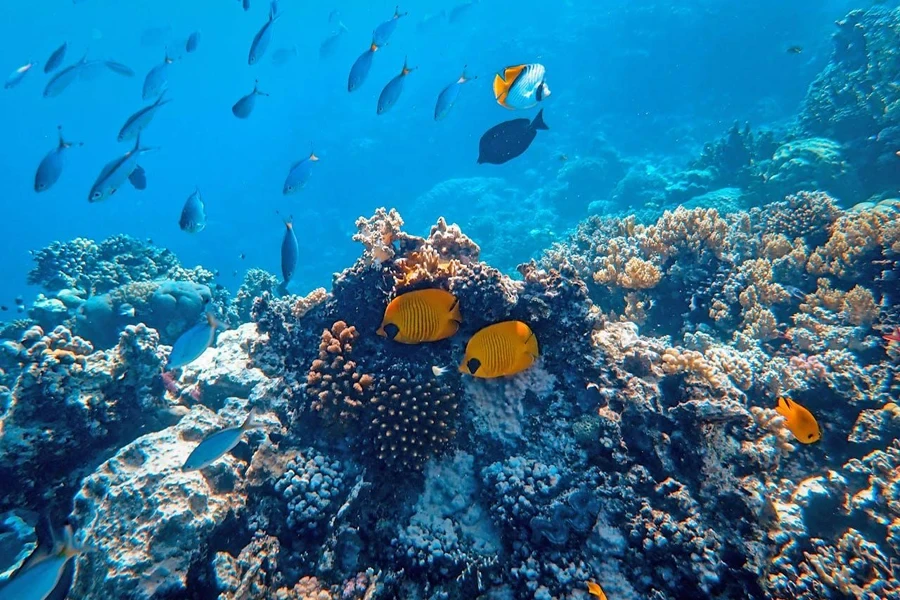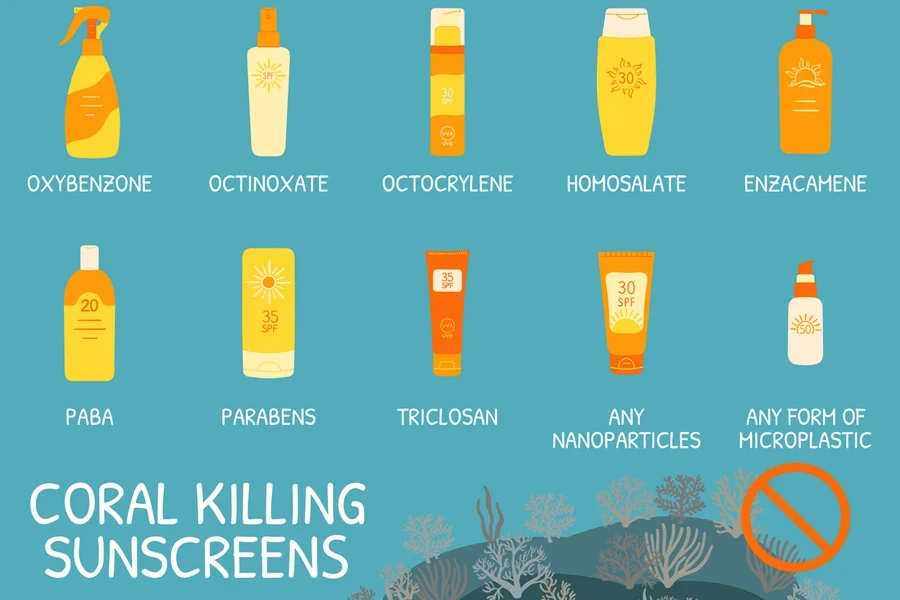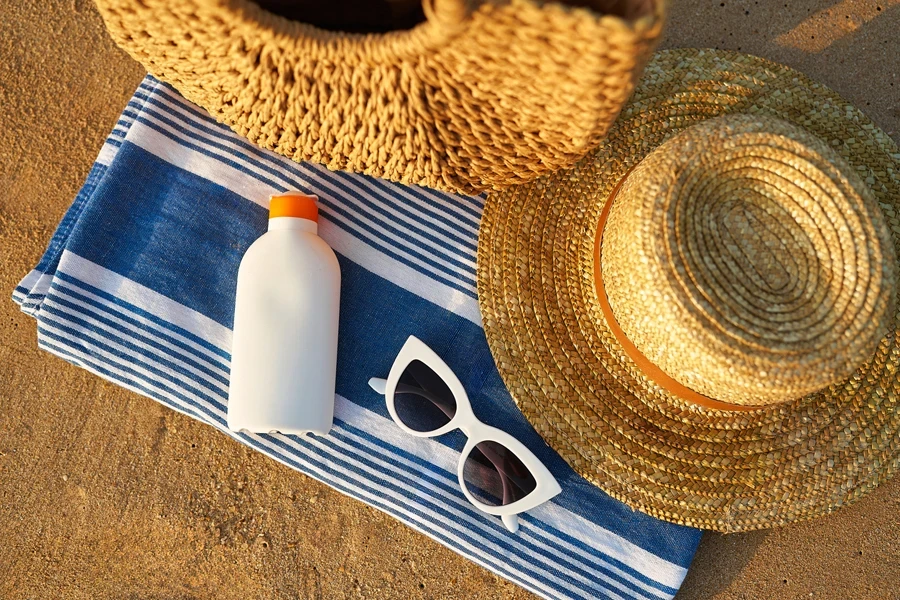We have reached a point where pretty much everyone knows the importance of wearing sunscreen to protect their skin from the sun. But, more recently, we have become aware of the impacts our sunscreen is having on the marine environment, particularly coral reefs. This has resulted in more companies creating reef-safe sunscreen to help prevent continued damage to the reef.
Here, we’ll dive into why reef-safe sunscreen matters, how to choose a safe product, and ways to protect both your skin and the environment.
Table of Contents
Why sunscreen affects coral reefs
What makes sunscreen “Reef Safe”?
Choosing the best reef-safe sunscreen
Other tips for reducing sunscreen’s impact on reefs
The future of sunscreen regulations
Final thoughts
Why sunscreen affects coral reefs
Before diving into the best reef-safe sunscreens, first, let’s talk about why it’s important to make the switch to reef-safe sunscreen and why the traditional sunscreen we’ve been using in the past impacts corals.
According to the National Parks Service, between 4 and 6 tons of sunscreen end up in our oceans every year as swimmers, divers, and surfers enjoy the water. Two common sunscreen ingredients, oxybenzone and octinoxate, have been shown to have toxic effects on coral reefs. These chemicals cause coral bleaching, DNA damage, and disruption of reproductive processes. According to a 2015 study, even a tiny concentration of oxybenzone (just 62 parts per trillion) can damage coral larvae and prevent them from developing properly.
What is coral bleaching? It’s a process that weakens coral reefs, making them vulnerable to disease and eventually leading to coral death.
Coral reefs are crucial for marine ecosystems, as they support around 25% of all marine species worldwide. Losing reefs to bleaching and pollution would devastate these ecosystems and the communities that rely on them.
The environmental impact of coral reef decline

The consequences of coral reef decline stretch far beyond beach destinations. Coral reefs play a role in protecting coastlines from erosion and storms, support global fisheries, and offer potential for medical research.
Coral reefs provide billions of dollars in tourism, recreation, and coastal protection each year. According to the National Oceanic and Atmospheric Administration (NOAA), the U.S. alone benefits by over US $3 billion annually from coral reefs. Protecting reefs through small changes, like switching to reef-safe sunscreen, can support the health of these vital ecosystems.
Additionally, coral reefs are crucial in the fight against climate change. They act as natural carbon sinks, capturing carbon dioxide and storing it in ocean sediments, which helps mitigate the effects of climate change. Without healthy reefs, this natural process is compromised, making it even more important to protect these ecosystems.
What makes sunscreen “Reef Safe”?
So, now that we are seeing “reef-safe” sunscreen on the market, it’s critical to know what it means for sunscreen to be reef-safe so you can make an informed purchase.
Reef-safe sunscreen is formulated without harmful chemicals like oxybenzone and octinoxate. Instead, these sunscreens typically use minerals like zinc oxide and titanium dioxide as active ingredients. These minerals sit on the skin’s surface and act as a physical barrier, reflecting UV and UVB rays away from the skin.
To be truly reef-safe, look for mineral-based sunscreens labeled as “non-nano.” Nano-sized particles are extremely small and can be ingested by marine life or potentially be absorbed into coral, causing additional stress. Choosing a non-nano mineral sunscreen (or plastic-free sunscreen) helps reduce this risk and keeps marine organisms safer.
Chemicals to avoid in reef-safe sunscreen

Here are some of the main ingredients to avoid:
- Oxybenzone: A chemical filter for UV rays, which is one of the main culprits of coral bleaching and DNA damage.
- Octinoxate: Another UV filter that contributes to coral bleaching and reproductive issues in marine life.
- Homosalate, octisalate, and octocrylene: These chemicals are often included in sunscreens and have shown toxic effects on marine ecosystems.
- Parabens and phthalates: Commonly found in beauty products, these ingredients are endocrine disruptors and can interfere with marine life reproduction.
Countries and territories with high coral populations, like Hawaii, Palau, and parts of Mexico, have even enacted bans on sunscreens containing oxybenzone and octinoxate due to their toxic effects on reefs. Hawaii’s ban, which took effect in 2021, is one of the most notable examples of this shift toward reef-safe practices.
Choosing the best reef-safe sunscreen

To help you make an eco-friendly choice, here are some guidelines for picking a high-performance mineral-based sunscreen:
- Look for labels that say “reef-safe” or “reef-friendly” and check the ingredient list to confirm the absence of harmful chemicals.
- Choose mineral sunscreens with non-nano zinc oxide or titanium dioxide. These ingredients are better for your skin and the ocean.
- Avoid spray sunscreens when possible. These products can disperse into the air and fall into the sand or water, impacting marine life.
Remember that some brands may label their products as “reef-safe” even if they contain certain ingredients that can still impact reefs. Reading labels closely can ensure you’re picking the best sunscreen option for your skin and the environment.
Is mineral-based sunscreen as effective as chemical sunscreens?
There has been some debate as to whether or not mineral-based sunscreens are as effective, with many people asking, “Are mineral-based sunscreens water resistant?”
One of the most important things when it comes to sunscreen is applying it properly and reapplying often. But, of course, for those who have active lifestyles or spend lots of time in the water, water-resistant sunscreen is important.
Other tips for reducing sunscreen’s impact on reefs

In addition to switching to reef-safe sunscreen, there are other ways to reduce your impact on coral reefs:
- Wear protective clothing like long-sleeved swim shirts, hats, and rash guards. Reducing the amount of sunscreen needed also decreases its potential to wash into the ocean.
- Apply sunscreen 15 minutes before entering the water. Giving sunscreen time to absorb into your skin helps prevent it from washing off immediately.
- Rinse off before entering the ocean if you’re applying sunscreen multiple times a day. This keeps excess sunscreen from washing directly into the water.
The future of sunscreen regulations
Countries worldwide are recognizing the harm of chemical sunscreens and are considering legislation to restrict them.
Following the Hawaiian ban, other places are exploring similar actions. The Pacific Island of Palau was one of the first to enact a full ban on harmful sunscreen ingredients in 2020, with other destinations, like the U.S. Virgin Islands, quickly following suit. As more scientific studies confirm the damaging effects of these chemicals on reefs, sunscreen regulations are likely to expand globally, especially in areas with vulnerable marine ecosystems.
As the beauty and skincare industry adapts to these changing regulations, consumers have a unique opportunity to lead the way by choosing eco-friendly products. Brands that are transparent about their ingredients and environmentally conscious in their production process will likely play a large role in shifting industry standards toward more sustainable practices.
Final thoughts
Switching to reef-safe sunscreen is a simple, effective way to protect your skin while doing your part to save coral reefs. By choosing products free from harmful chemicals, you can enjoy the beach responsibly, knowing your sunscreen is not causing harm to the ocean.
With the global spotlight on environmental protection, reef-safe sunscreens offer a meaningful way for travelers, beachgoers, and water enthusiasts to make a difference. It’s up to all of us to make conscious choices that benefit both our health and the planet.
Currently, global consumer demand for ocean-safe products is a greater force than legislation. Brands must adapt to their demands now rather than waiting for legislation, as consumers will likely consider this too little too late.




